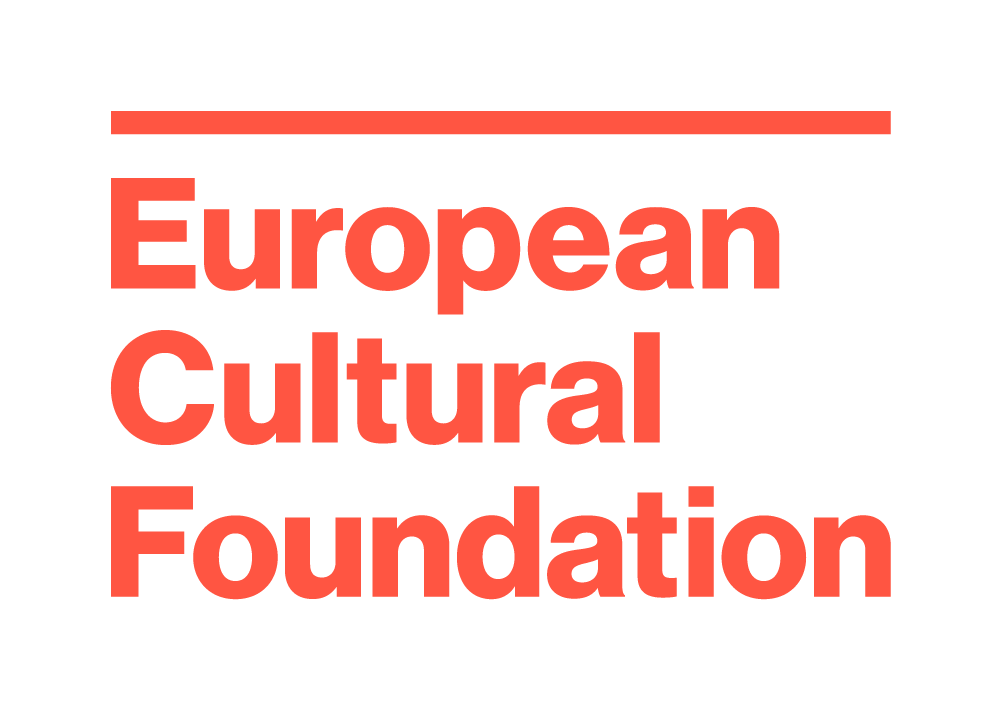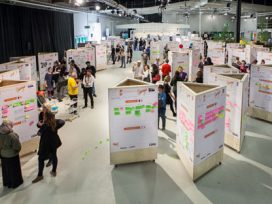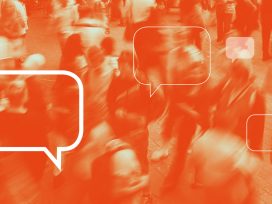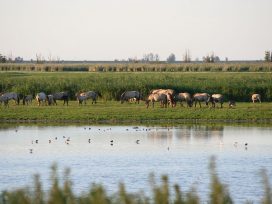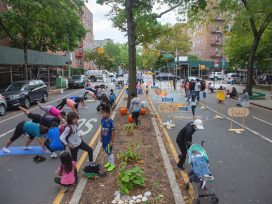In a text based on her presentation at Eurozine’s Oslo conference on the making of the public sphere, Pelin Tan explains how artist-run platforms are generating unique forms of solidarity, translocal networks and various types of transversal knowledge and alternative pedagogies. In so doing, Tan makes the case for a language that remains faithful to the project of rebuilding a collective consciousness.
What is our commons and how should it be
renewed, sustained, enlarged, drawn down, and/or extended to others?
J.K. Gibson-Graham
The creation of instituting society, as instituted society, is each time a common world (kosmos koinos), the positing of individuals, of their types, relations and activities; but also the positing of things, their types, relations and signification – all of which are caught up each time in receptacles and frames of reference instituted as common, which make them exist together.
Cornelius Castoriadis
From the perspective of my integrated relational practice in the field of urban, pedagogy and contemporary art, I am eager to convey how collective experience of the translocal production of knowledge and of instant alliances leads to the creation of common spaces for uncommon knowledge. Why is this important? Because, on both theoretical and practical levels, such processes could well be vital in enabling everyday life knowledge to intervene in institutional bodies, and vital to the flow of alternative pedagogies into different platforms, resulting in the emergence of creative forms of solidarity in extra-territorial spaces.
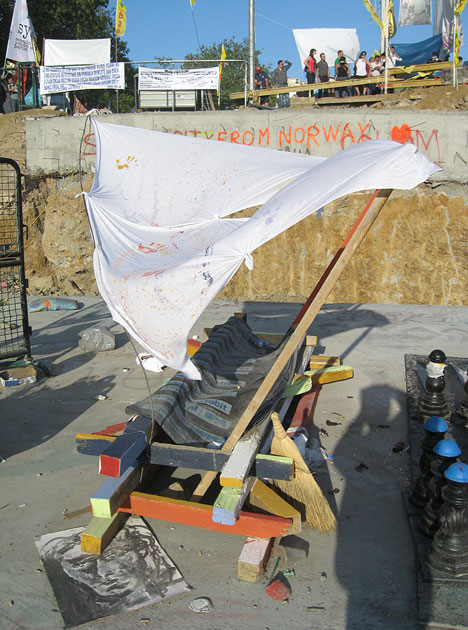
Source:#occupygezi architecture
What I do mean by “transversal dictionary”? A transversal dictionary would respond to the need to build a common vocabulary relating to labour, pedagogy, commons, archives, institutions and the urban that is connected to our struggle and resistance against conflict in our everyday practices. This need stems from spatial practices in conflicted urban spaces: it is a need not only for a language that relates to the constrained environment of the recent socio-political and economic crisis, but also for a language capable of rebuilding a collective consciousness that can convey our communal co-existence.
The question is this: how can self-organized, self-regulating networks and collective structures such as the urban Occupy movements inspire economic models, especially where the generation and redistribution of wealth are concerned? And how can the urban spaces in which these networks and structures emerge, under exceptional conditions, serve as “common knowledge” based on the practice of “commoning”?
Nowadays, we discuss precarious working conditions and their effects on cognitive labour. Currently, our understanding of the nature of precarious labour is mostly based on a time-work frame that leads to labour exploitation and lack of employment security, but these conditions do not necessarily correspond to our varying experiences of different work types. Rather, precarious labour and conflicts concerning production take on totally different dynamics, depending on which autonomous structures and networks they take place in. We can witness some examples of this in different geographies, where autonomous structures and collectives whose labour is based on relational collaboration and self-organization are being actively pursued and developed. There are practical cases of self-organized labour structures managing well on their own, not only to sustain production but also to maintain fluid networks of creative collectivism and collaboration, even though they may be limited to a certain extent by local territorial circumstances. Social Kitchen&Hanare (Kyoto), Souzy Tros (Athens), The Silent University (various locations), Decolonizing Architecture (West Bank), Architecture For All (Istanbul), Videoccupy (Istanbul) have all been founded by architects, artists and activists and are based on collectives responding specifically to the current economic crisis as well as the current wave of spatial colonization, which cannot be separated from the political.
Social Kitchen & Hanare
In 2012, I conducted research in artist-run spaces and activist collectives in Japan with a view to understanding the practices they produced and how these led to the creation of forms of urban justice and alternative livelihoods. Kyoto-based collective Social Kitchen&Hanare runs a heterogeneous economy based on the exchange of labour and a café generating income that covers basic infrastructure expenses, effectively making the project financially self-sufficient.
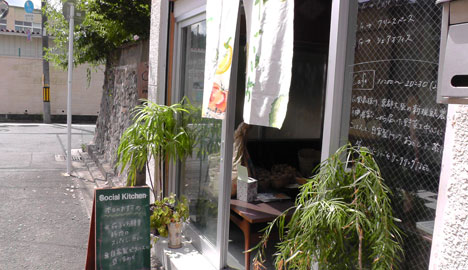
Photo: Pelin Tan.
The collective begun life in a member’s flat but had to look for another space upon facing conviction. The result of that search was a cheap space in which to run a café in collaboration with farmers, researchers, artists and designers who coordinate their labour and knowledge in organizing action for urban justice as well as events, reading groups and discussions in Social Kitchen space.
Souzy Tros
Under austerity, heavy surveillance and stringent migration policies in the urban space of Athens, a similar space was created on the initiative of artist Maria Papadimitrou, with the help of artists, architects, designers, NGO workers and immigrants. Entitled Souzy Tros, it was established as a food/sewing/art/design space based on the free exchange of labour. Artist Maria Papadimitrou’s equates to a vision of a “coming community”, a community that seems impossible to form but appears in a collective imaginary through everyday life practices.
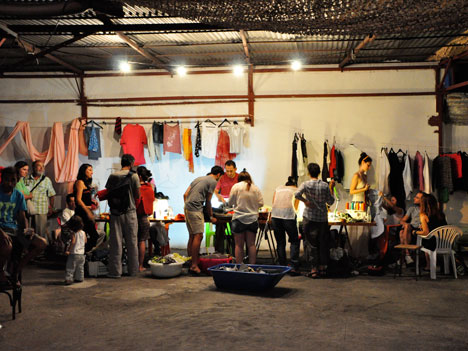
Photo: Pelin Tan.
The old question about the role of art in society becomes more important in this example, especially in the context of the recent global economical crisis, the domination of authoritarian neoliberal governments and the weakening of social ethics. What do the practices of Souzy Tros or Social Kitchen mean for us? They remind us that there are imaginative futures in store for communities, that there are collective practices that remain to be invented, that there are alternative methodologies for creating institutional structures and pedagogies, and that artistic production can introduce various forms of labour production beyond time-space and also dissemination of surpluses.
Urban pedagogy and commoning
Most of these groups and networks are involved in urban pedagogy based on tools of empowerment and self-learning, teaching, acting, research, reclaiming alternative urban space, social media, urban farming and the reclaiming of city centres threatened by aggressive real estate development plans. Additionally, they undertake daily activities, collaborating with temporary workers, the homeless and disenfranchised communities to create support structures for these groups. Besides their autonomous structures, they also try to create models criticality connected to new forms of social relations and commoning. Examples of this can be seen in the organization of discussion groups, collective actions, urban movements and general meetings. From this perspective, their work can be seen as a research method for a practice of commoning – of being in common. I think that what is central to the meaning of “commons” is not what we own or share or produce in terms of property, but rather “social relations” that are closely connected to everyday life.1
According to political economist Massimo De Angelis, “Commons are a means of establishing a new political discourse that builds on and helps to articulate the many existing, often minor, struggles and recognizes their power to overcome capitalist society.”2 He defines three notions in order to explain not merely the commons in terms of the resources that we share but a way of commoning, that is, a social process of “being common”: the way in which resources are pooled and made available to a group of individuals, who then build or rediscover a sense of community. Food sociologist and activist Raj Patel focuses on the role of food in social movements and the forms of solidarity it underpins,3 whether that be the Black Panther movements that organized children’s breakfasts or the People’s Grocery or Via Campesina. He defines commons: “Commons is about how we manage resources together.”4 But his argument is not only about managing and sustaining food growing and sharing but also about how food-related movements should act in solidarity with other movements. Thus the concept of “commons”, as understood here, holds a sensitive position within any given community or public, especially in contested territories or cities subject to the threat of the neoliberal destruction of their built environment. Negotiation and the resolution of conflicting values are key to such commoning practices. As Stavros Stavrides argues, more than the act or fact of sharing, it is the existence of common grounds for negotiation that is most important. Conceptualizing commons with reference to the public does not focus so much on similarities or commonalities but on exploring the very differences between people on a purposefully instituted common ground. We have to establish grounds for negotiation rather than grounds for affirming that which is shared.5
Decolonizing Architecture
In Decolonizing Architecture, Al-Masha refers to “common land” instead of “commons”: “The notion of Al-Masha could help re-imagine the notion of the common today. Could this form of common use be expanded by redefining the meaning of cultivation, moving it from agriculture to other forms of human activity? […] How to liberate the common from the control of authoritarian regimes, neo-colonialism and consumer societies? How to reactive common uses beyond the interests of public state control?”6 Based in the “occupied territories” of the West Bank , this practice, which draws on the field of architecture, focuses on the reality of Palestinian refugees creating common spaces and perceiving the notion of the “camp” as a potential space beyond neoliberal citizenship and the dichotomy of public vs private space.
In the activities of Decolonizing Architecture, the “common” differs both from public and private space. As we see in most cities and urban spaces, public and private spaces are under the control of governments. Decolonizing Architecture collaborates with different background researchers, refugees, activists and civil representatives in using militant urban and architectural research methodologies to identify common spaces in the refugee camps and former military buildings. Working with the inhabitants of Fawar camp, for example, they have designed a small public space that was then realized by young Palestinian refugees and families. A space for the exchange of everyday life experiences and local engagements can be the most important form of resistance against colonization.
The Silent University
Another platform of alternative knowledge production and exchange is artist-run practice The Silent University, an autonomous knowledge exchange platform by and for refugees, asylum seekers and migrants. The Silent University aims to challenge the idea of silence as a passive state, and explore its powerful potential through performance, writing, and group reflection. These explorations attempt to make apparent the systemic failure and the loss of skills and knowledge experienced through the process of silencing people who are seeking asylum. The Silent University, which was initiated by artist Ahmet Ögüt in cooperation with many researchers (including myself), has two principle, intertwined structures. These deal firstly with the notion of subjectivity among refugee and asylum seekers, which is defined under a “state of exception”. Secondly, it practices a new form of alternative pedagogy in which knowledge production foregrounds the co-existence of both the refugees themselves and of the public.
The whole structure as a mobile academy is a transversal machine where “citizenship” is experienced beyond clear borders. As a form of translocal borderless knowledge production, The Silent University handles issues of citizenship, education, institutionalism, borders, war, being a refugee, documents/documenting, urban segregation, commons and others. This practice produces an “uncommon knowledge” about the shared experiences of humans and their representation. Thus it applies alternative research methods that involve artistic research and deconstruct common methodologies. In this context, The Silent University produces digital spaces using various online platforms and social media in order to disseminate printed works and initiate discussions between researchers and academics with a view to creating a performative archive and developing transversal research methodologies.
Visuality
If I spoke from an academic point of view (as a so-called social scientist), I would claim that a methodological crisis has occurred in research in recent years, stemming from the shortcomings of a conservative, closed-circle orthodoxy in academia. Aside from the issue of pursuing quantitative and qualitative research methodologies in isolation from one another or the problems of grounding theory in empirical practice, the discussion of embedded situational research methods has been much neglected in academia. Additionally, the multiplicity of new forms for contemporary knowledge production urges us to adapt our methods. Furthermore, from a Deleuzian perspective, in our complex societies, “data” is a rhizomatic assemblage that needs to be searched, evaluated, analysed and represented using complex tools or, indeed, new research tools invented accordingly.7
This means that visuality as both a concept and a product is not only a representation of knowledge but also the machine that drives it. Therefore in contemporary art production, such as in the case of The Silent University, the practice itself becomes a “method”, which is a challenging notion not only in the field of contemporary art but also in methodological discussions in fields such as education, social sciences or urban conflict. I would therefore prefer not to call The Silent University a “project” but an instituting practice, an archive-in-the-making and a method.
It could be compared to the Videoccupy collective, which I founded with video activists on 2 June in Gezi Park in Istanbul. The initiation aimed to visually record memories and to archive the resistance process between 27 May and 31 July 2013; they have collected recordings done with devices such as iPads, phones and video cameras and created an archive comprising of the whole collected material. For us, using video and creating videograms as an emancipative device, not only during the Gezi resistance but also in our everyday lives, we do not consider ourselves to be showing or representing but rather producing the potentialities of the action of “I see”.
Self-organization
With reference to the practices of assemblages and potential instant alliances mentioned above, it is important to consider how the labour exchange strategies applied operate. They are generally based both on immaterial and physical labour, there is no separation between these forms of labour production. Here, the alienating aspects of immaterial labour disappear and the surplus is handled on the basis of ethics rather than capitalist market imperatives. In this context, community economies and surplus dissemination processes, in the sense implied by economist-geography researcher J.K. Gibson-Graham, are of particular importance. For political collective action requires “working collaboratively to produce alternative economic organizations and spaces in place.”8 Further: “The ‘collective’ in this context does not suggest the massing together of like subjects, nor should the term ‘action’ imply an efficacy that originates in intentional beings or that is distinct from thought. We are trying for a broad and distributed notion of collective action, in order to recognize and keep open possibilities of connection and development.” 9
In short, collective action requires the ethics of a community economy. I fact, I would articulate this more as an act of ethics of locality that meets the needs suggested by our everyday knowledge and the experience of safeguarding our livelihoods in both urban and rural spaces.10 The relational network established as a result is more of an instant community that chooses to think and discuss together rather than a normative structure. Self-organization is not a simple hierarchy based on certain labour activities and their division but, conversely, a work/labour structure that allows one to be a farmer in the morning and a graphic designer in the afternoon. To reiterate Stavrides’ sharp analysis, collaboration is not about affirmation, but negotiation. It is about debating critical issues in an urban space, where space itself is a pressing and compelling concern. Creating collective, non-clerical, political action in the urban space is not about the organization or the event itself, but about co-existing and functioning together to achieve commoning. This is rooted in a reconsideration and realization of our practices of collaboration, alternative economies, autonomous networks, self-organization and surplus strategies, all of which radically differ from the reality of the neoliberal policies and logics of production currently being forced upon us.
The Gezi Park resistance
The Gezi Park resistance experience is about collaborating, moving in solidarity despite our differences and conducting voluntary work, creating a non-partisan, non-clerical yet democratic platform. And, it is about friendship. Before the government dispersed the Gezi Park protestors on 15 June, food, beverages and provisions for all other needs were managed by self-initiated groups. Furthermore, a vegetable and flower garden was even set up in the park. As seen here, all self- or collective initiatives are based on voluntary labour exchange in general terms, but they also go beyond this, as exchange labour in this case is not a practice where one could be called a “volunteer.” Being a “volunteer” here both exceeds and diminishes this new form of working together, as the “voluntary” in labour represents the very source of the power of collective action.
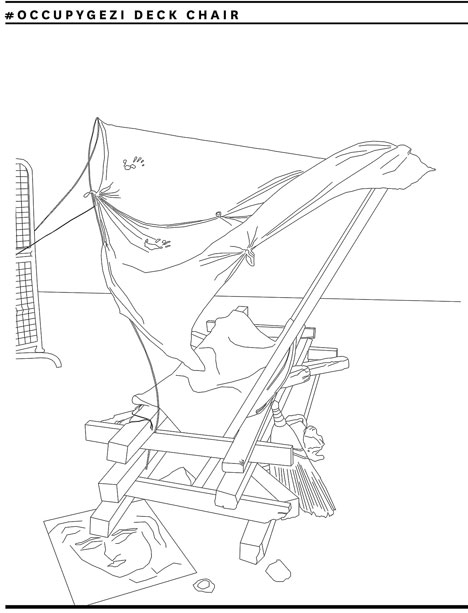
Source:#occupygezi architecture
The Istanbul-based collective Architecture for All (Herkes Için Mimarlik) created architectural drawings of adhoc structures in Gezi Park and along the barricades during the Gezi resistance. During the Gezi resistance there was a temporary mosque, a mobile food collective run using simple materials and a tent, an ever-expanding open hospital… these are examples of in situ and instant architecture in Taksim Square and Gezi Park. Makeshift markers represent the borders of each section and places in Gezi Park that marks the function of the places; the markers expand or shrink according to people’s needs. More often than not, performative architecture is experienced during a “state of emergency”, under conditions of conflictual urbanism, instant architecture and practices of radical spatial resistance. These relational resistance structures led Architecture for All to create the #occupygezi architecture initiative, in which they claimed: “We need new definitions for architecture in situations when architecture is removed from architects. Each unique structure that we encounter in the streets and Gezi Park has its own in-situ design and implementation process.”
A communal practice of difference
We find ourselves at a stage in global history where local movements consisting of self-organized collectives are attaching themselves to translocal networks capable of creating rhizomatic dissemination and surplus. At the same time, the Occupy movements in different cities have introduced a realm of communal practice of difference that has gathered already existing collective resistance practices. The differences between these movements, from the 1999 Seattle WTO protests onwards, and those of the twentieth century has already been discussed in the works of Michael Hardt and Antonio Negri, along with questions surrounding the heterogeneity of labour and communities. The anti-globalization protests that followed Seattle and continued with the Occupy movements are characterized by unique forms of solidarity, translocal networks and various types of transversal knowledge and pedagogy.
According to philosopher Simon Critchley, “We can talk about Occupy. Occupy is not revolution – it is rebellion – but it is very interesting and it has made a very different set of political tactics available. Occupy is something very familiar to many of the people on the anarchist Left. […] I believe in a low-level, almost invisible series of actions, which at a certain point reach visibility and then really have an effect. As Gramsci would say, politics is not a war of manoeuver or frontal assault on power. It is a tenacious and long-lasting war of position. This requires optimism, cunning and patience.”11 Furthermore, for Franco “Bifo” Berardi, Occupy movements are characterized by taking pleasure in the other body, and an empathy for other alliances.12 In my opinion, we cannot and do not speak of a new activism anymore; we do speak about an uncommon knowledge that we create, a new instituting power and a collective labour. This can be linked back to the practice of Decolonizing Architecture and its participants’ intention of questioning the “commons” from the perspective of Al-Masha: the form of research “is collective, relational and active”. In the context of which, I think that concepts such as “participation”, “agonism” and “hegemony” that we often use in practicing radical democracy are transformed in the process of more layered, conditional and foundational negotiations that questions our values, relations and ways of acting in our current society. The differences between institutional knowledge and its production can be challenged accordingly, with a view to creating a co-existence that is at once active and fictive, and that touches everyday and urgent realities. It is just like when Decolonizing Architecture describe the ideas behind their actions, which are conducted, they say, in order “to establish a different balance between withdrawal and engagement, action in the world and research, fiction and proposal.”13
We are at that moment right now.
Bibliography
J.K. Gibson-Graham. The End of Capitalism (As We Knew It). Minnesota Press, 2006.
Cornelius Castoriadis The Imaginary Institution of Society, trans., K. Blamey. MIT Press, 1998.
"Ways of Commoning / Mustereklestirme Pratigi", David Harvey ile söylesi, New City Reader, söylesiyi yapanlar: Pelin Tan ve Ayse Çavdar, Haziran 2012, Istanbul. Cf. David Harvey, Rebel Cities: From the Right to the City to the Urban Revolution, Verso, 2012.
An Architektur, "On the Commons: A Public Interview with Massimo De Angelis and Stavros Stavrides", e-flux Journal 17 (2010), www.e-flux.com/journal/on-the-commons-a-public-interview-with-massimo-de-angelis-and-stavros-stavrides/
Cf. Raj Patel, "The Hungry of Earth", Radical Philosophy 151 (2008), rajpatel.org/2009/11/02/the-hungry-of-the-earth.
Slowfood Terra Madre Meeting 2010, panel discussion on social systems and transformations with Serge Latouche and Raj Patel, 23 October 2010, Turin (notes from the presentation of Raj Patel by the author).
An Architektur, "On the Commons: A Public Interview with Massimo De Angelis and Stavros Stavrides", e-flux Journal 17, www.e-flux.com/journal/on-the-commons-a-public-interview-with-massimo-de-angelis-and-stavros-stavrides/
Sandi Hilal, Alessandro Petti and Eyal Weizman / Decolonizing Architecture, Architecture After Revolution, Sternberg Press, 2014
Pelin Tan, "Review of Deleuze and Research Methodologies, edited by Rebecca Coleman and Jessica Ringrose, Edinburgh Press, 2013", Visual Studies, doi:10.1080/1472586X.2014.887316.
J.K. Gibson-Graham, The End of Capitalism (As We Knew It), Minnesota Press, 2006
Ibid.
Pelin Tan, "Locality as a discursive term in recent socially engaged art", PhD thesis, ITU Art History, 2010
Simon Critchley, Pelin Tan, "Breaking the Social Contract", e-flux journal 38 (2012), www.e-flux.com/journal/breaking-the-social-contract/
Running Along the Disaster, workshop with Franco "Bifo" Berardi, 22-24 April 2014, Otonom Publishing, Pelin Tan and Önder Özengi (LaborinArt), Istanbul
Sandi Hilal, Alessandro Petti and Eyal Weizman / Decolonizing Architecture, Architecture After Revolution, Sternberg Press, 2014
Published 30 May 2014
Original in English
First published by Eurozine
© Pelin Tan / Eurozine
PDF/PRINTIn collaboration with
In focal points
- Creating the commons in Spain: The current state of play
- Creating the commons in Moldova: The current state of play
- The city belongs to all of us
- No collaborative economy without commons
- Polish culture is turning barren
- The power to refuse
- Culture WITH people, not just FOR people!
- When commoning strategies travel
- A rough guide to the commons
- New models of governance of culture
- Uncommon knowledge
- The changing nature of environmental expertise
- From Attac to Occupy Wall Street
- The power of minus
- Interactions of the technical and the social
- Living in the matrix
- New media and democracy in post-Soviet countries
- The revolution begins with Rosia Montana
- When the feet become the head
- The liquid library
Newsletter
Subscribe to know what’s worth thinking about.
Related Articles
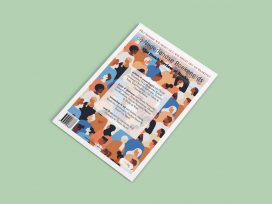
On making commons concrete
The Dutch Review of Books 2/2021
‘The Dutch Review of Books’ presents: the commons, vying for legitimacy between state and capitalism; the void of societal responsibility for #MeToo; and African oral traditions evident in rap music.
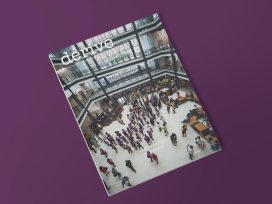
Democratic ‘Third Places’
dérive 10–12/2020
Urbanist magazine ‘dérive’ on emancipating Brazilian museology; the potential for Polish cultural centres; Swiss commons as a transferable prototype; and post-explosion Beirut.
